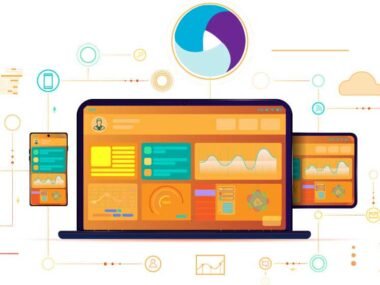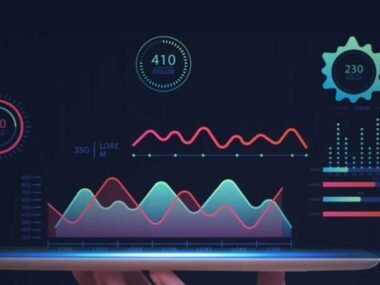Did you know that the document management system market is expected to reach $19.2 billion by 2033? This shows the growing demand for efficient document editing and management solutions.
Technology is always changng. Document editing has seen major advancements. New tools and features make editing easier and faster.
The future of document editing will bring even more innovations. Text and visual content will be easier to edit and share. This guide explores key innovations shaping the future of document editing.
The Rise of AI in Document Editing
AI is changing how we edit documents. It can suggest edits and fix grammar mistakes. AI can even predict the next word in a sentence.
Machine learning helps AI learn from users. AI can also check tone and style. It helps writers match their audience’s needs.
These tools save time and reduce errors. They help users write with confidence. AI will continue to improve document editing in the future.
Collaborative Editing Made Easy
Collaboration is the future of document editing. Remote work is growing fast. Teams need tools to edit together in real-time. Editing platforms make this possible.
Multiple users can edit and comment at the same time. Version control helps track changes. Built-in chat features let teams discuss edits easily.
Real-time editing boosts creativity. It allows for quick feedback and improvements. Collaboration makes document editing more efficient than ever.
Cloud Integration and Accessibility
Cloud storage has changed how we handle documents. It makes sharing and storing files easier. It also reduces the risk of losing important work.
Users can access cloud documents from any device. This allows editing and viewing from anywhere. Work is no longer limited to an office.
Cloud storage creates more flexible work options. Teams can collaborate without being in the same place. Automatic backups prevent data loss.
Advanced Formatting Tools
Formatting documents is now easier than ever. New Documentation tool help create clean and professional designs. Features like drag-and-drop images and templates save time.
Style guides ensure a consistent look throughout the document. Users can also add videos and interactive graphics. These elements make documents more engaging.
Content is now more than just plain text. Modern tools help capture the audience’s attention. Better formatting improves readability.
Smart Templates
Smart templates help save time. They remove repetitive tasks in document editing. Pre-designed fields and automation make editing easier.
Users can quickly create contracts, invoices, and proposals. It reduces the time spent on drafting and formatting. This allows professionals to focus on important work.
Smart templates improve efficiency. They help maintain consistency in documents. These tools make editing faster and stress-free.
Mobile Document Editing
Mobile devices are now essential for work. People need to edit documents on the go. Mobile apps provide powerful editing tools.
Editing on a phone or tablet is convenient. Users can work from anywhere. This flexibility makes it easier to stay productive.
Mobile editing boosts efficiency. Quick edits can be done anytime. These tools help users manage tasks with ease.
Text to Speech and Speech Recognition
Speech technology is changing document editing. Text-to-speech lets users listen to their content. This helps with proofreading and catching mistakes.
Speech recognition allows users to dictate text. This makes writing faster and more natural. Talking instead of typing saves time.
Hearing text makes errors easier to spot. They will become even more useful. Speech technology is shaping the future of document editing.
Enhanced Security Features
Sharing documents is more common than ever. Strong security features are needed to protect files. Future editing tools will have better encryption.
User authentication and access controls will add extra safety. These features keep sensitive information secure. Only authorized users can make changes.
Security tools help maintain document integrity. Secure document editing keeps user data safe.
Integration with Other Software Solutions
Document editing is now more connected. Many tools work with project management and email apps. CRM systems can also link with document editors.
Users can edit and share files without switching apps. This saves time and effort. Seamless integration boosts productivity.
More tools will connect in the future. Editing will be even more streamlined. Better integration will improve the entire document process.
Data-Driven Insights for Improvement
Data analytics is changing document editing. It helps track user engagement and editing history. Feedback loops provide useful insights.
Data shows how readers interact with documents. This helps writers make better edits. Improved accuracy makes content more relevant.
Companies rely on data for decisions. Understanding document usage is important. Data-driven editing will shape the future of content creation.
Dynamic Document Formats
Documents are becoming more interactive. Static files are being replaced with dynamic formats. These formats adjust based on user preferences.
HTML5 enables dynamic features. Users can add interactive elements and real-time graphics. Content can change based on reader input.
More tools will support dynamic formats. Customizable content will improve user experience. The future of documents will be more interactive and flexible.
Personalized User Interfaces
Document editing is becoming more user-friendly. Personalized interfaces will improve the experience. Users can customize toolbars and layouts.
Custom features help users work more efficiently. They reduce the learning curve for new software.
People can focus on the tools they use most. This makes editing easier and more intuitive. Productivity will improve with personalized settings.
Augmented and Virtual Reality Applications
AR and VR are changing document editing. Users can edit in a virtual space. Teams can collaborate in shared augmented environments.
Immersive editing enhances creativity. Users can visualize data in new ways. Virtual tools make collaboration easier.
Editing will feel more natural and dynamic. AR and VR will shape the future of document creation. These features improve teamwork and engagement.
Feedback and Review Systems
Editing tools are improving feedback options. Users can track changes and comments easily.
Rating systems help analyze document quality. These features make reviewing more effective. Strong review systems improve writing.
Authors get detailed feedback on their work. This helps refine content for better clarity. Careful reviews lead to higher-quality documents.
Blockchain for Document Integrity
Blockchain can improve document security. It records every edit in a secure ledger. This creates a verifiable history of changes.
Blockchain prevents tampering and misinformation. Every change is recorded. This ensures that documents remain reliable.
More companies will adopt this technology. Secure editing will become more common. Blockchain will make document management safer and more transparent.
Usability for All: Accessibility Improvements
Document editing must be accessible to everyone. New features will help people with disabilities.
Alternative input methods will make editing easier. These tools allow more people to create content. Accessibility features support different user needs.
Inclusive design makes editing fair for all. Everyone can contribute without barriers. Inclusive editing will become the standard.
Modular Editing Environments
Modular editing lets users customize their workspace. They can choose which tools to display. This makes editing more efficient.
Users can keep only the features they need. A clean workspace reduces distractions. Editing becomes faster and easier.
Attention to Cultural Sensitivity and Inclusivity
Global collaboration is growing. Understanding cultural differences is important. Future editing tools may detect sensitive content.
Inclusive editing promotes respect. Tools can suggest better word choices. They help create content for diverse audiences.
Writers will adapt content for different readers. Sensitivity in editing will become standard. This improves communication and understanding.
Document Editing as a Service (DEaaS)
Editing is moving toward service-based models. DEaaS provides expert editing without software installation. Users can access advanced tools online.
Small businesses and freelancers benefit the most. They can use professional editing without high costs. This increases accessibility for all users.
DEaaS will continue to grow. More features will be available online. Editing will become more affordable and efficient.
The Power of the DOCX SDK
The DOCX SDK makes document management easier. It allows users to create and edit documents programmatically.
Businesses can build custom applications for their needs. This improves efficiency and workflow.
Reports and summaries can be generated quickly. This reduces manual work and saves time. Consistency in documents is also improved.
Increased Focus on User Experience (UX)
User experience is key in document editing. Developers are improving interface design. Editing tools are becoming more intuitive.
Features like drag-and-drop improve usability. Customizable toolbars help users work faster. A smooth interface enhances productivity.
Competition is driving better UX. Companies focus on user-friendly platforms. Better UX leads to higher satisfaction.
Optical Character Recognition (OCR)
OCR converts scanned documents into text. It makes old records searchable and editable. This technology helps users access important information.
OCR improves document management. Businesses can digitize paper records easily. This saves time and reduces clutter.
More industries are using OCR. It helps in legal, medical, and financial fields. Accuracy continues to improve with AI.
Multi-Language Grammar Correction
AI can now correct grammar in many languages. It helps users write more accurately. This makes communication clearer and more professional.
Writers can improve their skills easily. Editing in different languages becomes faster. Businesses benefit from better global communication.
Embracing the Future of Document Editing
Document editing is changing fast. New technologies are making it more advanced. AI-powered tools are improving editing.
Embracing these innovations is important. They help users create and share easily. The future of editing will support creativity and productivity.
Explore more fascinating topics on our website. Dive into our other articles for more information.










